For effective pest control in your container garden, start with natural methods like companion planting—pair marigolds with your tomatoes to keep pests at bay! If those pesky aphids show up, try a homemade garlic spray. You’ll love how it keeps them from munching on your greens! Regular check-ins for shiny leaves, sticky residue, or webbing help catch pesky invaders early. Curious about more ways to protect your thriving garden? Let’s explore further!
Understanding Common Pests in Container Gardening
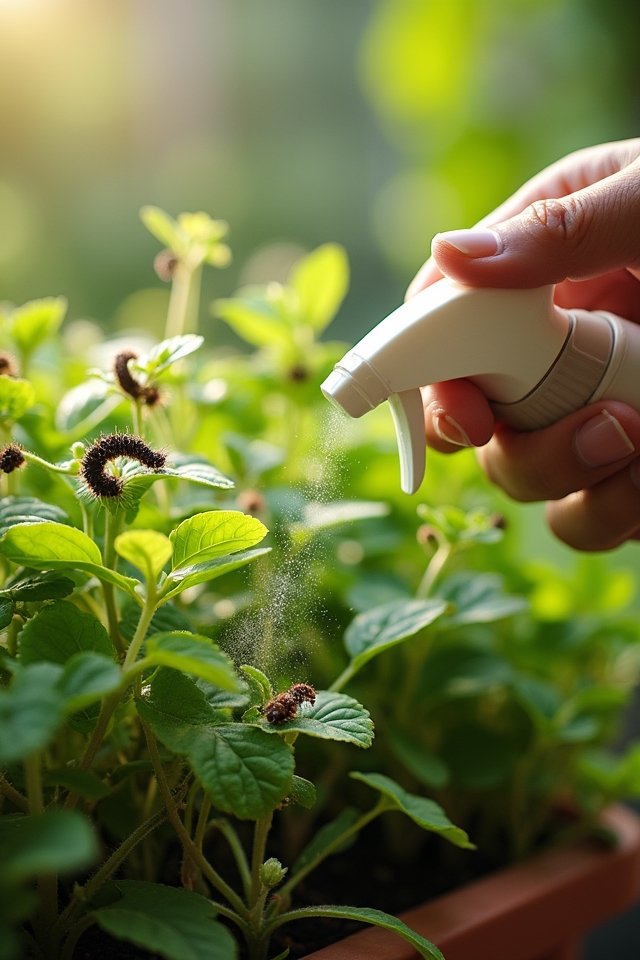
When you’re nurturing your beloved container plants, it’s like giving them a cozy home, but watch out — pests can crash the party! Think of aphids as tiny uninvited guests, turning your flourishing greens into a buffet. To keep your beauties thriving, you’ll need savvy pest identification techniques. Are you spotting sticky residue or distorted leaves? Those signs hint at their sneaky presence! Remember, container plants have unique vulnerabilities due to limited soil and space. Whiteflies may flutter about, while spider mites create webs that resemble bad holiday decorations. Take a good look at your plants, tap into your inner detective, and spot those pests early. Trust me, a little vigilance keeps those unwelcome critters out of your garden!
Natural Pest Control Methods
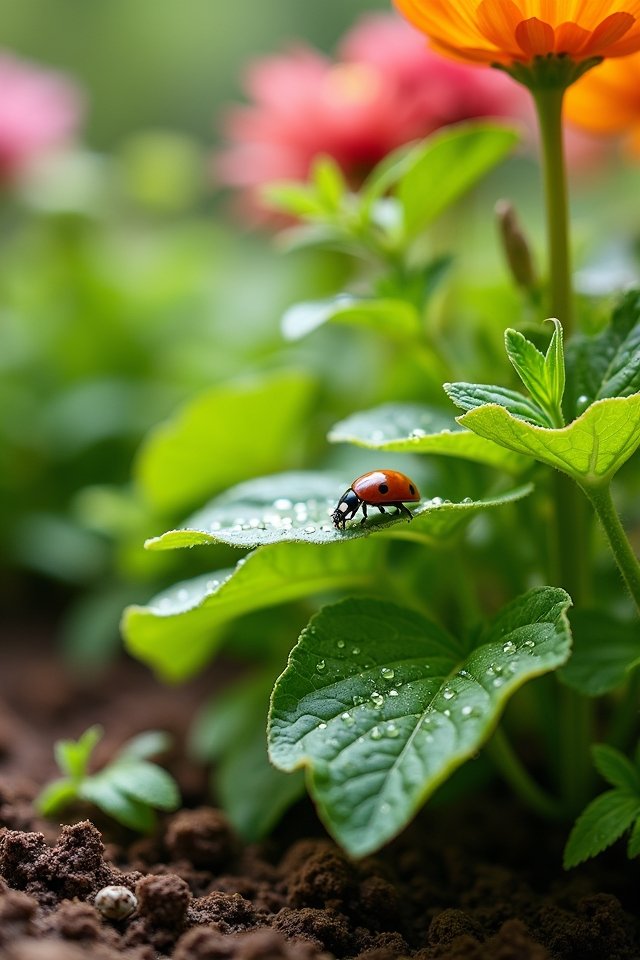
Now that you’ve sharpened your detective skills for spotting pesky intruders, it’s time to roll up your sleeves and explore natural pest control methods that can keep your container plants thriving! Think of companion planting as setting up a guard squad; for example, placing marigolds next to your tomatoes can deter those nasty aphids! Isn’t that genius? You can also whip up homemade sprays using garlic and water—just blend, strain, and spray away! The pungent aroma will send pests fleeing while your plants bask in the glory of fresh air. So, why not adopt these innovative tactics? Your container garden will flourish, and you’ll feel like a true eco-warrior, all while keeping things naturally simple and joyfully green!
Chemical Pest Control Options
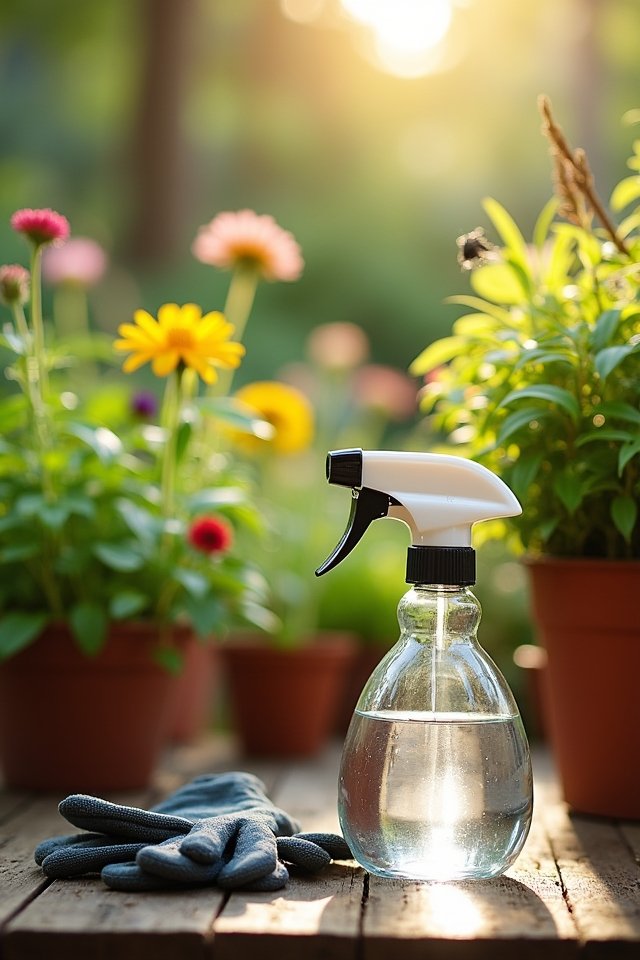
While natural methods can be super effective and eco-friendly, there are times when a little chemical help can do the trick! Chemically formulated products bring a powerful punch against pests like aphids and spider mites. You’ll find options like insecticidal soaps or neem oil that are easy to apply; just mix and spray! Employing clever application techniques—like targeting the undersides of leaves—can supercharge your results. Think of it as giving your plants a protective shield, ensuring they thrive without those pesky intruders! Just remember, moderation is key. A little goes a long way! And don’t forget to check labels for safety instructions. You want those leaf-loving friends to flourish, right? So, gear up and welcome the chemistry of pest control!
Preventive Measures for Pest Management
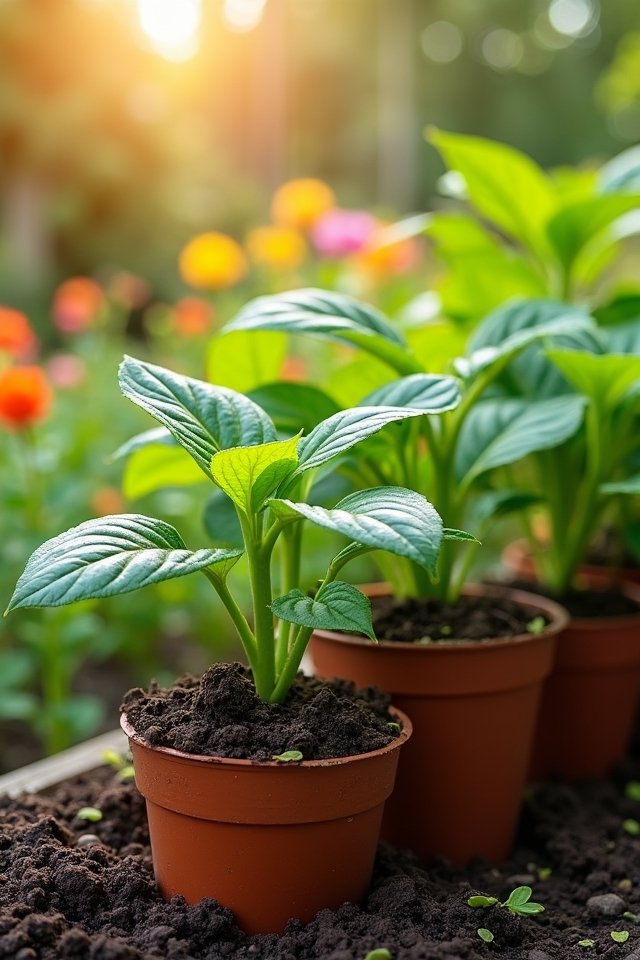
To keep those container plants thriving, think of pest management as your friendly garden shield! You want to create a healthy environment that repels pests while promoting soil health. So, let’s get innovative with some preventive measures:
- Cultural Practices: Rotate your plants! Changing their positions disrupts pests’ cozy habitats and prevents infestations.
- Soil Health: Invest in high-quality soil! Rich, nutrient-dense soil boosts plant immunity, making them less appealing to unwelcome critters.
- Companion Planting: Mix and mingle! Pairing plants can naturally deter pests—like planting marigolds to keep aphids at bay!
Embrace these strategies and watch your plants flourish, free from pesky intruders! It’s all about being proactive—happy gardening!
Monitoring and Identifying Infestations
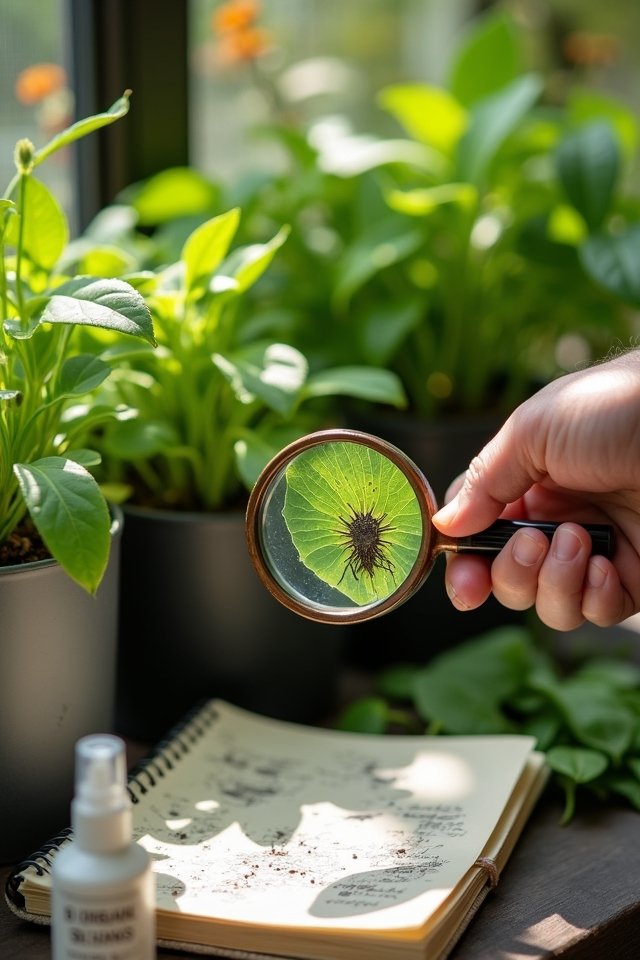
How can you keep your beloved container plants in tip-top shape while keeping an eye out for pests? It’s all about keen observation! Use innovative pest detection techniques, like checking for shiny leaves or webbing—both crucial infestation symptoms. Got discolored leaves? That’s usually a red flag!
Regularly inspect your plants, seeking clues like sticky residue or tiny black specks. You’re like a detective, solving the mystery of the munching intruders! If you spot any unwelcome guests—like aphids or spider mites—it’s time to act! Remember, early detection is essential. Think of it as a game; the sooner you recognize the signs, the better your plants will thrive. Happy monitoring, and may your container garden flourish!
Beneficial Insects for Pest Control
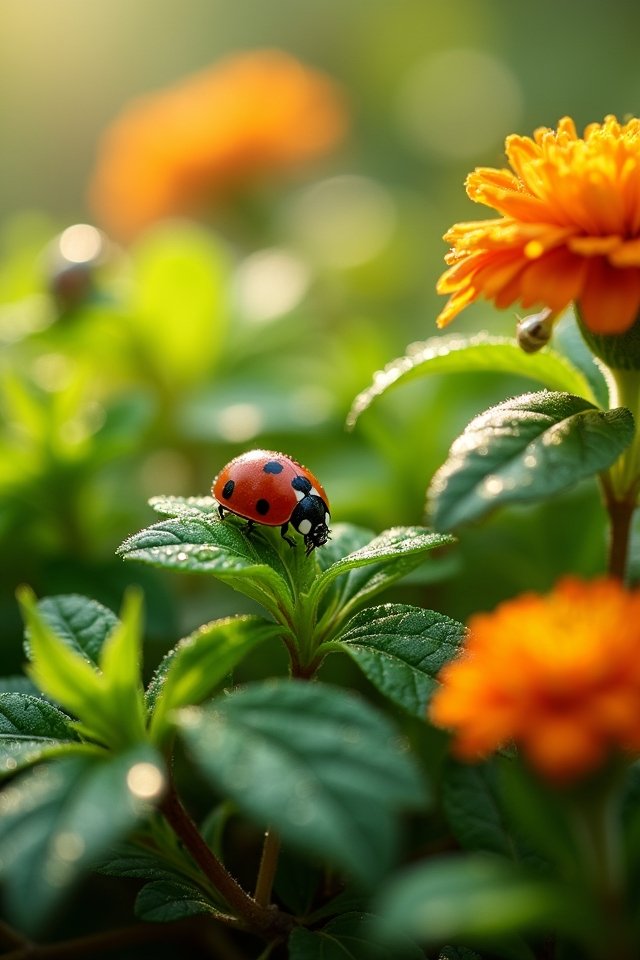
Once you’ve sharpened your detective skills in spotting pests, it’s time to call in the cavalry: beneficial insects! These tiny allies are a game-changer for your container plants. Just imagine, you’ve got a secret army ready to battle pesky invaders.
- Ladybugs: Their voracious appetite for aphids means healthier plants—talk about ladybug benefits!
- Predatory Wasps: They may be small, but these wasps lay eggs in pests, naturally reducing their population. It’s like pest control magic!
- Green Lacewings: These beauties hunt down soft-bodied insects, acting like vacuum cleaners for your plants.
Seasonal Pest Control Strategies
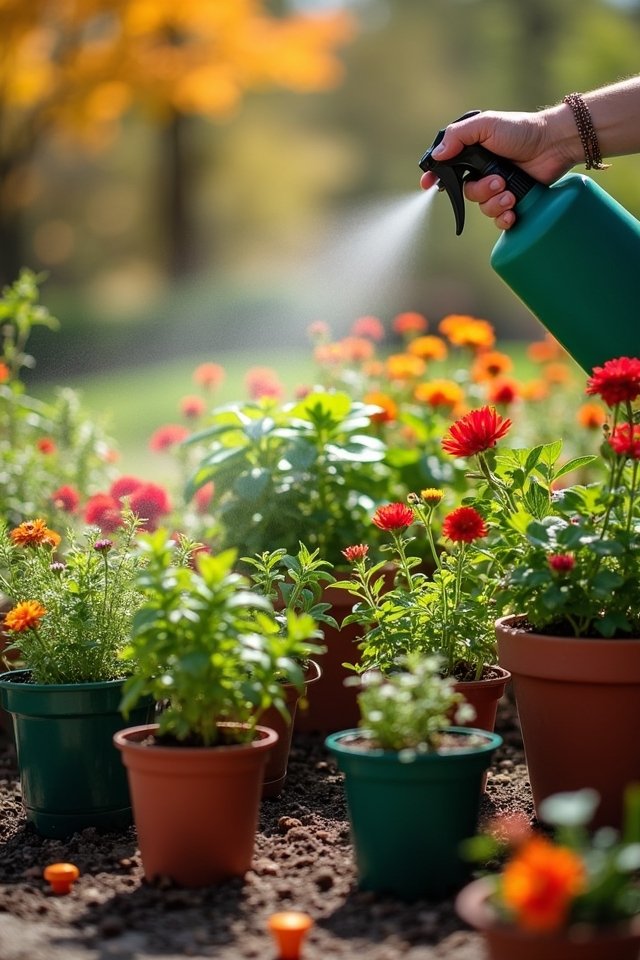
As you savor the changing seasons, don’t forget your container plants need a bit of seasonal love too! With every shift in weather, pests, like sneaky ninjas, adjust their life cycles. In spring, use insecticidal soap to target aphids before they invade your tender leaves. By summer, introduce beneficial beetles for a protective army against pesky aphids. As fall arrives, make neem oil your best ally against those winter-wintering threats. And in winter? Well, it’s time to get cozy! Check for any hidden bug refugees—trust me, they love to challenge your indoor oasis. Keep embracing these innovative strategies; your plants will thrive, and you’ll enjoy watching them flourish year-round! Isn’t that what it’s all about?
Frequently Asked Questions
How Often Should I Inspect My Container Plants for Pests?
How often should you inspect your plants for pests? Imagine spotting a sneaky spider mite before it turns your vibrant blooms into drab shadows! Regularly checking your container plants—at least once a week—is essential for effective pest identification techniques. Notice any strange changes? That’s your cue! Pair this with good container plant maintenance to keep your garden thriving. Remember, a little attention now saves a lot of trouble later. Happy gardening!
What Signs Indicate a Severe Pest Infestation?
You’ll know you’re facing a severe pest infestation when your plants start looking like they’ve been through a mini tornado! Check for pest damage, like munched leaves or tiny webbing that resembles a bad Halloween decoration. Also, look for infestation symptoms like yellowing or wilting leaves, sticky residue, or even the little critters scuttling about. If it feels like a bug party, it’s time to take action before your greens suffer too much!
Can Pests Survive Winter in Container Plants?
Absolutely, pests can survive winter in container plants! They use clever winter strategies, like burrowing into the soil or hiding under leaves. Imagine little pests snuggling in for a cozy hibernation! You might think, “What about my plants?” Well, just like you bundle up in a warm blanket, pests find protection in your containers. So, check your plants regularly! Vigilant care keeps your garden thriving and pests at bay. Happy gardening!
Is It Safe to Use Sand to Deter Pests?
Is it safe to use sand to deter pests? Absolutely! Sand’s effectiveness as a pest deterrent is impressive. Imagine your soil, transformed into a fortress! When you sprinkle sand on top, it creates a prickly barrier that pests like slugs and ants find downright annoying. They’ll think twice before invading your cozy plant kingdom. Just remember, sand won’t solve every pest problem, but it can sure kick some critters to the curb! Happy gardening!
How Do I Dispose of Infested Plants Safely?
Did you know that about 20% of plants get infested with pests each year? So, if you’re dealing with infested plants, don’t panic! First, consult your local composting guidelines—some pests can hitch a ride in compost. You can safely bag and dispose of them in regular trash. Just remember, no one wants a pest parade in your garden! It’s like tossing confetti at a party, but trust me, this confetti’s a no-go!


